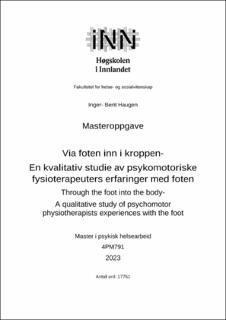| dc.contributor.advisor | | |
| dc.contributor.author | Haugen, Inger- Berit | |
| dc.date.accessioned | 2023-07-06T16:10:46Z | |
| dc.date.available | 2023-07-06T16:10:46Z | |
| dc.date.issued | 2023 | |
| dc.identifier | no.inn:inspera:145666155:91493604 | |
| dc.identifier.uri | https://hdl.handle.net/11250/3076703 | |
| dc.description.abstract | Sammendrag
Bakgrunn:
I psykomotorisk fysioterapi er det et prinsipp som vektlegger å bygge kroppen nedenfra. Et godt fundament kan gi rom for frie bevegelser og fri pust. Egenerfaring har gjort meg nysgjerrig på fotens rolle i kroppen. Det finnes lite eksplisitt forskning på akkurat dette temaet, noe jeg med min forskning forsøker å bidra med inn til Norsk psykomotorisk fysioterapi (NPMF).
Hensikt og problemstilling:
Hensikten med denne oppgaven er å finne ut hvordan psykomotoriske fysioterapeuter erfarer foten, i psykomotorisk behandling av pasienter med langvarige helse utfordringer. Dermed lyder problemstillingen: På hvilken måte erfarer psykomotoriske fysioterapeuter at de ser, møter og forstår pasientene via foten?
Metode:
Kvalitativ design er valgt i denne oppgaven og systematisk tekstkondensering (STC) utviklet av Malterud er valgt som analyse metode. Den er basert på pragmatisk filosofi og tilnærming. Det er gjennomført fem semistrukturerte dybdeintervju.
Resultat:
Det var tre tydelige hovedfunn i resultatet av forskningen min: Gjennom den fysiske foten kan vi komme inn til det følelsesmessige ved mennesket. Kontakt med føttene kan roe tankekaoset. Retningen i livet kan komme fra føttene.
Konklusjon:
Føttene kan avsløre kroppslig belastning og være en viktig inngang til menneskers følelsesliv. Føttene kan være startstedet for en terapeutisk allianse. Sansemessige erfaringer fra føttene kan være starten på en samtale som kan lede til positive endringer for pasienter med langvarige helseutfordringer. Noen ganger kan man ikke begynne behandlingen i føttene, det er en motsetning til det postulatet i NPMF hevder om å bygge kroppen nedenfra. Da er belastningene for store og føttene er ikke tilgjengelig for pasienten. | |
| dc.description.abstract | Abstract
Background:
In Norwegian psychomotor physiotherapy a central principle is building the body from the bottom up. A well-built foundation gives opportunity for movement and breathing. Experiences from my own practice made me curious about what role the feet play as a foundation for the rest of the body. There is very limited information on this idea explicitly, therefor the intent of the study is to contribute towards increasing knowledge in this research area.
Purpose and question:
The purpose of this paper is to figure out how psychomotor physiotherapists experience the influence of the foot, especially in long term treatment of health problems. The thesis-question to be addressed: In what way do psychomotor physiotherapists experience that they see, meet, and understand the patient through the foot?
Method:
This Master is of qualitative design and uses systematically text condensation (STC) composed by the Malterud method, based on pragmatic philosophy and approach. Five semi-structured depth interviews were conducted.
Results:
Three main results were identified: Through the foot we can reach the emotional element of individuals. Contact through the foot can ease the thought chaos. Guidance/direction in life can come via the feet.
Conclusion:
The feet can uncover bodily load and will be an important gate to the emotional life of an individual. The feet can be the starting point for the formation of a therapeutic alliance. A sensory experience from the feet can lead to the initiation of conversation this bringing about positive changes for long term health problems. On some occasions, treatment cannot start in the feet, even though this is a significant principle of NPMF. This is because the load is too large, and the feet are inaccessible for the patient. | |
| dc.language | nob | |
| dc.publisher | Inland Norway University | |
| dc.title | Via foten inn i kroppen- En kvalitativ studie av psykomotoriske fysioterapeuters erfaringer med foten | |
| dc.type | Master thesis | |
